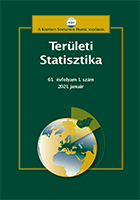Ingázás a nagyvárosba – Egy országos igénymodell
felállítása
Commuting to the city – Setting up a national demand model
Author(s): Zsombor Szabó, Tibor SiposSubject(s): Social Sciences, Economy, Geography, Regional studies
Published by: Központi Statisztikai Hivatal
Keywords: commuting;transportation; spatial econometrics;
Summary/Abstract: In the field of transport sciences, the study of transport services, including public transport services, is of paramount importance. The opportunities provided by the state to meet the transport demand are mostly intercity buses as well as railway services. In order to evaluate the services between the different settlements and to determine the value of the equal transport network, it is essential to develop a kind of exchange system between the individual modes of transport, to find the socalled Weight numbers. Weights can be displayed based on a number of parameters, such as passenger numbers and connections. However, the aim of our article is to determine a generalized transport mode number by which public transport as an infrastructure may be characterized as a whole. To this end, we set up a national demand model based on a gravity model and determine how much transport demand each regional center generates in the settlements of the region to which it belongs. The demands generated in the demand model thus defined are identified as dependent variables. We fit a spatial econometric model using the bus and rail traffic characteristic of the settlements as explanatory variables, so that the generalized transport modality numbers identified as targets and suitable for comparison can be determined.
Journal: Területi Statisztika
- Issue Year: 60/2020
- Issue No: 05
- Page Range: 581-605
- Page Count: 26
- Language: Hungarian

